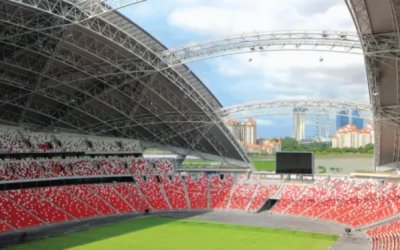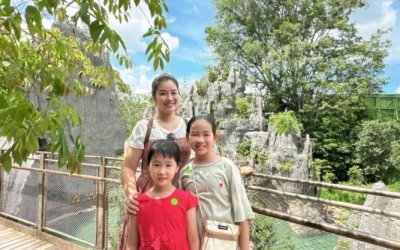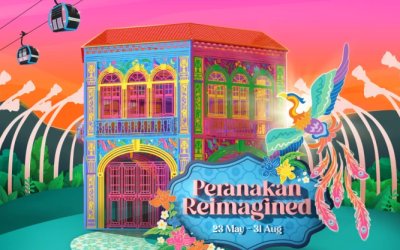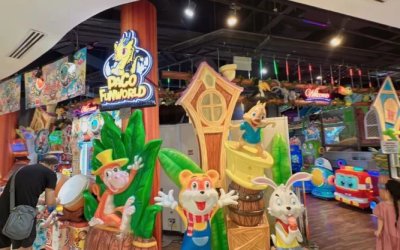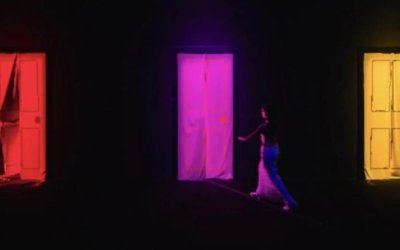Exhibition Information
展覽信息
when and how to visit the exhibition? click the below image
點擊以下圖片獲取觀展詳情
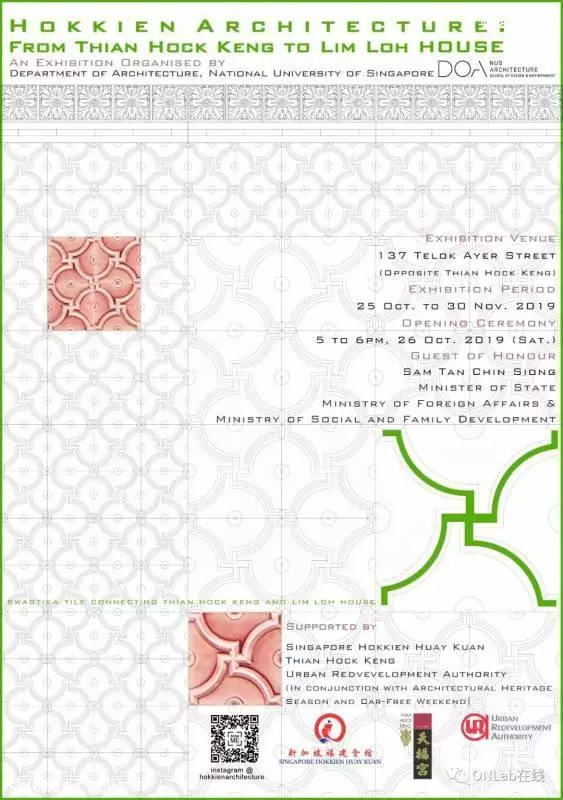
Forewords
前言
本次展覽呈現二零一八至二零一九學年新加坡國立大學建築系學生的閩南僑鄉行所學。憑藉面對天福宮的場地優勢,突出這座在新加坡地位崇高的福建人廟宇,與頭家林路(林謀盛少將的父親)在南安祖籍地修建的宗祠之間的關聯,展示新加坡華族建築的影響,揭示先民將南洋式樣與審美趣味帶回福建。同時紀念林謀盛少將犧牲七十五周年,展現他鮮為人知的家庭生活,為自由與正義做出的犧牲。
This exhibition features learning from the Southern Fujian fieldtrips made in AY2018-2019 by students from the Department of Architecture, National University of Singapore. Taking advantage of the immediate visual association with Thian Hock Keng, this site-specific exhibition highlights the connection between this predominant Hokkien temple in Singapore and the ancestral houses in Nan'an built by Towkay Lim Loh (Major-General Lim Bo Seng's father).
It features Chinese architectural influences in Singapore, as well as how the unique style and sense of aesthetics of Nanyang (South Seas) had been brought by the early settlers to their hometowns in Fujian. To commemorate Major-General Lim Bo Seng’s 75th death anniversary, this exhibition provides vignettes to his little known family life and attempt to piece together a richer picture of one of Singaporean’s well-known martyr.
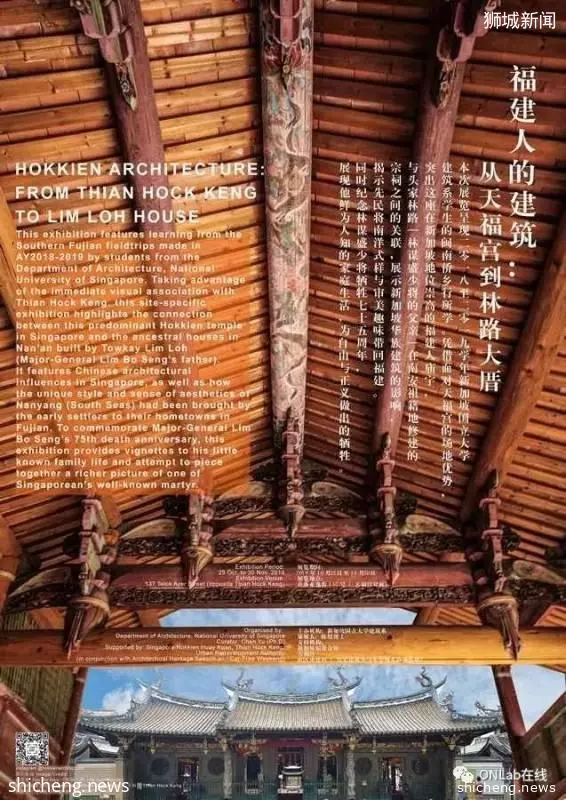
What is the link between Thian Hock Keng and Lim Loh House?
天福宮與林路大厝有什麼關聯?
自一八四零年起,天福宮一直是新加坡福建人的信仰中心,也是福建人的建築典範,一九零六年天福宮進行大規模翻修,鋪設瓷磚與地磚。幾乎在同一時期,林路在南安後埔老家興建九十九間大厝,閩南俗語稱:「有林路富,無林路厝」,指的是林路大厝建築的恢弘奇巧。林路大厝採用與天福宮一樣的瓷磚與地磚,表達他對這種建築裝飾的喜愛,也顯示南洋文化在福建的影響。
Since 1840, Thian Hock Keng has been the spiritual centre of Hokkien community, and a prime example of Hokkien architecture in Singapore. In 1906, Thian Hock Keng underwent a large-scale renovation, during when decorative and flooring tiles were installed. Almost at the same time, Lim Loh built his ninety-nine room house in hometown Houpu, Nan』an. There is an old saying in Southern Fujian: 「One may have wealth as much as Lim Loh, but one will not have a house like his!」, referring to the extraordinary architecture of Lim Loh’s house. The tiles used in Thian Hock Keng were also found in Lim Loh House. This coincidence shows his preference for this kind of architectural ornament, and therefore the influence of Nanyang in Fujian.
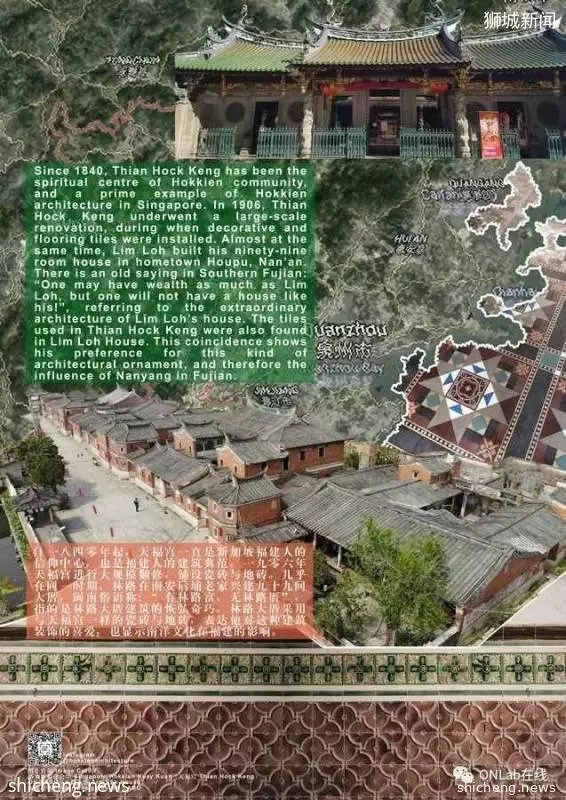
Who is Lim Loh?
誰是林路?
林路出生於福建南安後埔(今省新鎮滿山紅村),年少時下南洋,後在新加坡成為成功建築商、商人和慈善家,活躍於華社,領導興建了許多標誌性建築。其十一子林謀盛為新馬抗日英雄。
Born in Houpu, Nan』an, Lim Loh (1852~1929) was a self-made man. He migrated to Malaya at a young age and became a successful building contractor, businessman and philanthropist. He was active in Chinese community and led the construction of many landmarks in Singapore. War hero Lim Bo Seng was his 11th son.
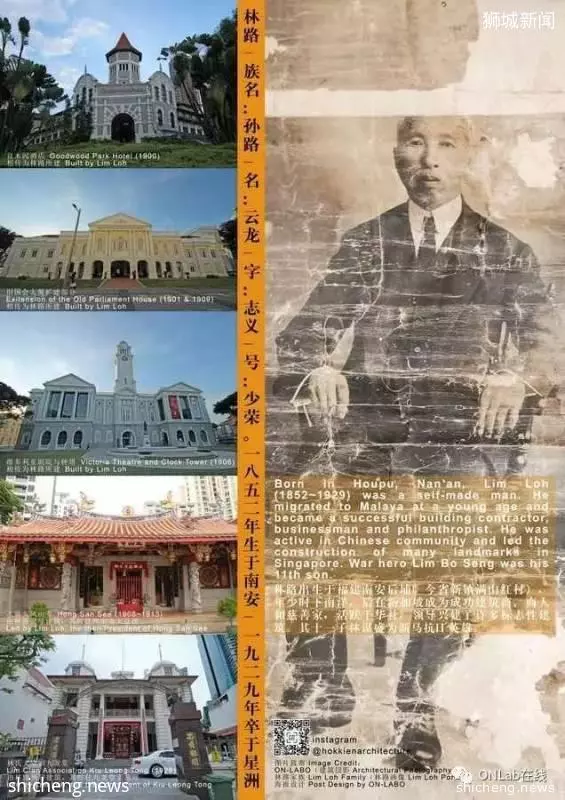
War Hero Lim Bo Seng and His Sacrifice
抗日英雄林謀盛與他的犧牲
「林少將是在中國出世的,當他還是兒童的時候,就來到此地,他在新嘉坡的商場以及政壇上都樹立了聲譽,他為他自己所選擇的邦土而戰鬥,他更為馬來亞的自由而犧牲他的性命。」
林慶年
林烈士謀盛紀念委員會主席
一九五四年六月二十九日
「General Lim was born in China. He came to Malaya when he was still a boy and made for himself a good name in business as well as in the political fields in Singapore. He fought for this land of his adoption, and he died for the freedom of Malaya.」
Lim Keng Lian
Chairman of Maj.-Gel. Lim Bo Seng Memorial Committee
29 June 1954
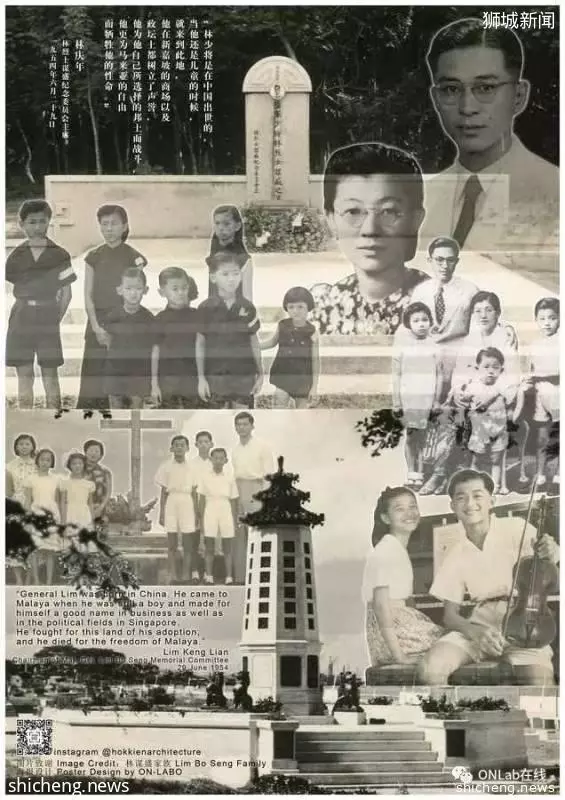
Lim Bo Seng's Birthplace and the Education He Received
林謀盛的出生地與他所接受的教育
林謀盛一九零九年出生、成長於南安林路大厝,其父林路在疊樓二層廳堂留下族訓,引用朱柏盧之治家格言教導子孫後代。
Lim Bo Seng (1909~1944) was born and grew up in Lim Loh House, Nan』an. To nurture and educate his descendents, Lim Loh had the family maxims inscribed on the walls of the main hall, which was situated on the second level of the Stacked Block. The writings were quotes from Zhu Bolu’s 「Maxims for Managing the Home」.
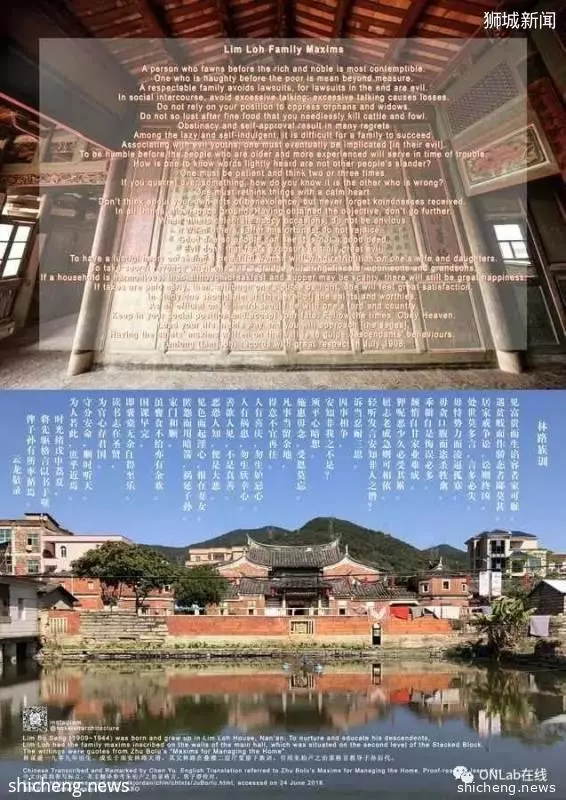
Significane of Lim Loh House
林路大厝的意義
林路大厝建築工藝精湛,建築創新與實驗手法、裝飾與紋樣、材料與工藝,有著南洋影響,對於理解新加坡建築歷史有著深遠意義。
Lim Loh house shows excellent art-crafting, creative solutions to technical challenges and experimental use of vernacular materials to achieve western detailing. The House's ornamentation, design motifs, use of materials and building technique are indications of Nanyang influence. The study of Lim Loh House enables better understanding of the architecture history in Singapore.
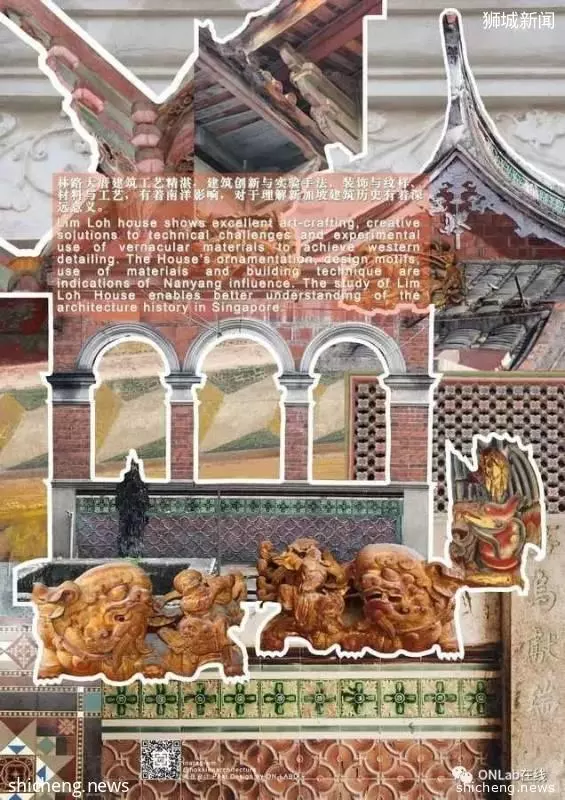
Southern Fujian Fieldtrip
閩南僑鄉行
走進僑鄉,面對一棟棟廢棄閒置的僑房,推開緊閉的門扉,觸摸著曾經輝煌的痕跡,眼前似曾相識的南洋風物,斯人已逝,今人已散。福建先輩在不同領域為新加坡的發展做出重大貢獻,閩南僑鄉行提供了難得的機會,讓我們了解先輩與祖家之間的個人情感,我們希望更多的人能探訪他們的祖籍地,那裡有共同的記憶與共享的文化資產。
Historic buildings are physical links to our past. Revisiting hometown of our forefathers, we listened to stories in the past and gained insights to philosophy and world views of a generation that has helped built modern Singapore. These stories, told through memorabilia and architecture, are little known beyond local communities. Our fieldtrips in Southern Fujian provided a rare opportunity to study our forefathers' personal relationships with their hometowns. We hope that more people will visit their ancestral places where there are shared memories and common heritage.
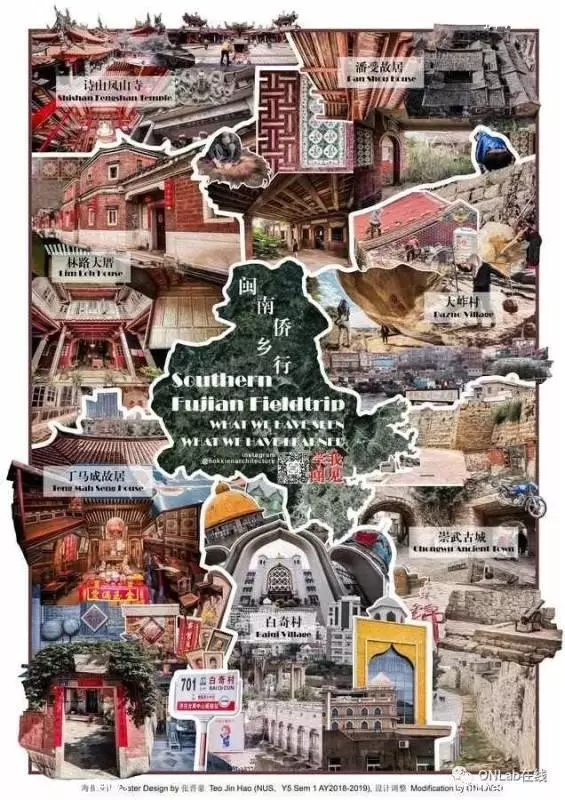
Three Key Aspects of the Field Study
考察的三大要點
華僑宅邸 OVERSEAS CHINESE HOUSE
起屋、休墳、興學是華僑人生三大金福,我們參訪了一些由新加坡福建人在不同時期興建的華僑宅邸,包括林路大厝、丁馬成故居、潘受故居、黃奕歡故居等。
The three golden joys of an overseas Chinese is to build a house, grave and school in one’s hometown. We visited several overseas Chinese houses built in different periods of time by Hokkien from Singapore, including Lim Loh House, Teng Mah Seng House, Pan Shou House, Ng Aik Huan House, etc.










